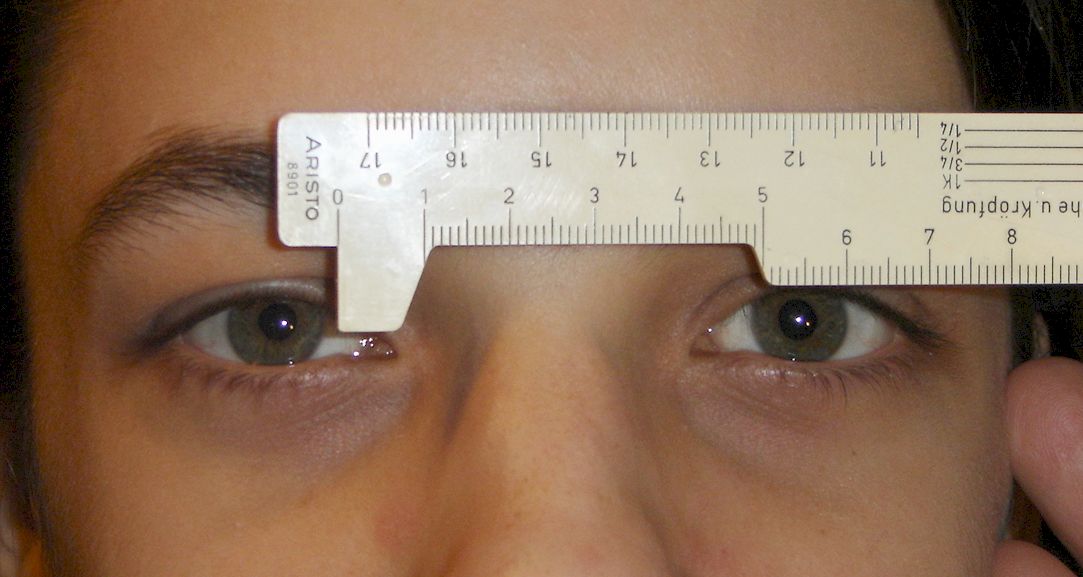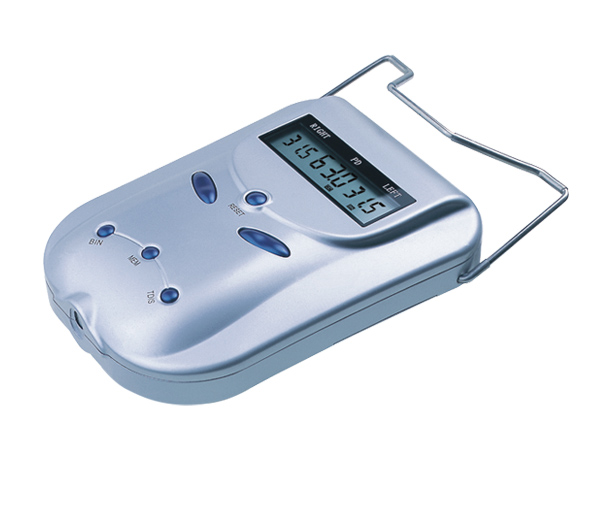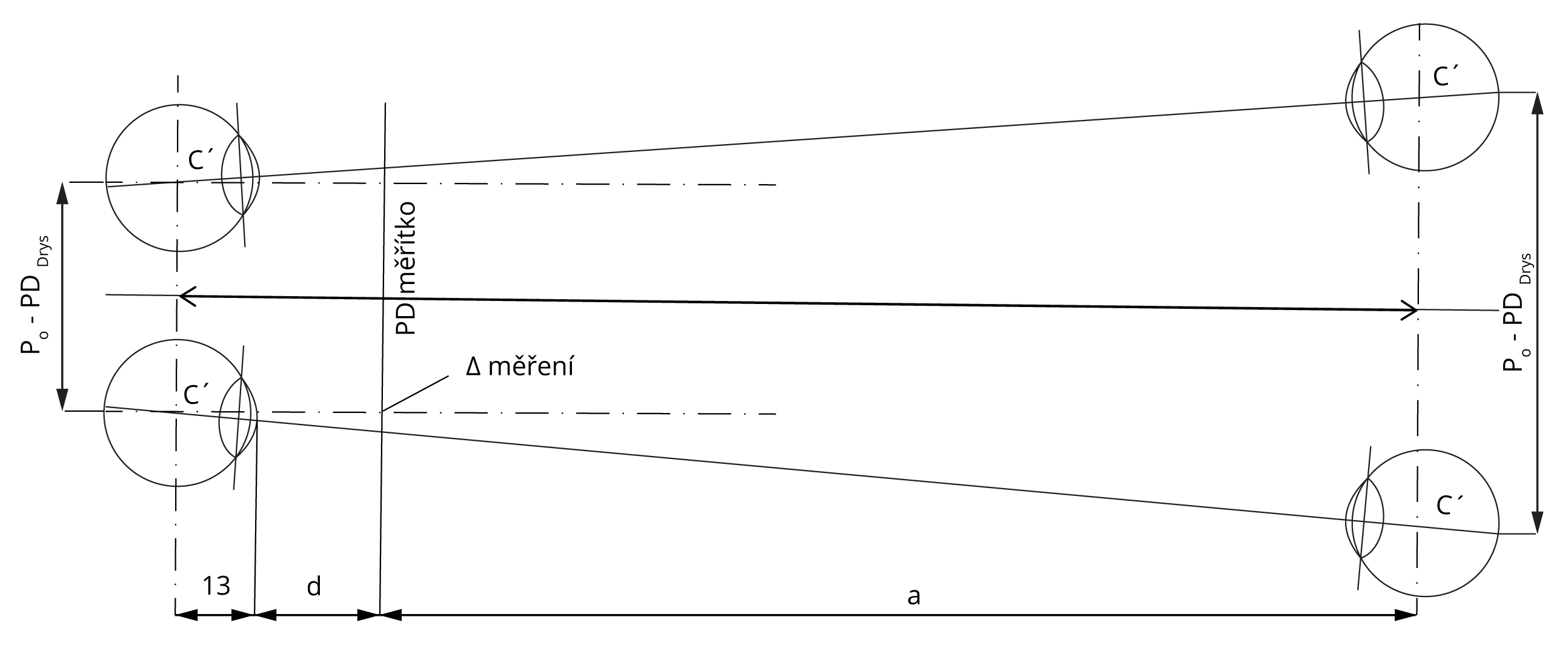1. Pupillary distance measurement for far
Introduction
Pupillary distance (PD) is distance between pupils. We can usually measure it in millimeters. It is individual value and it can change during the life. This value is very important because it can influence spectacle lens centering. PD can be measured when fixing on objects located far away, near or other specific distance. Near PD is usually smaller due to convergence. Expected values in population are 70 mm for men, 65 mm for women and 55 mm for children (Wikipedia). Anton (2006) shows values from 61 to 65 mm in men over 15 years and from 60 to 62 mm in women. Monocular measurement is distance from nose middle point to center of the pupil of the right eye and separately for the left eye.

PD measurement is possible to do with hand PD ruler, digital pupillary meter, drawing on demo-foil of the spectacles or with the electronic video centering system. It is better to measure PD for right eye and for the left eye because these values can be different.


Goals
- Measure PD with direct Victorian method with drawing on demo-foil
- Measure infinity-converged PD with PD ruler
- Measure PD with digital PD meter
- Calculate influence of parallax in direct method
Equipment
Spectacles with demo-foil, hand PD ruler, digital pupillary meter, pencil for plastic foil
Methods
Measure PD with direct Victorian method with drawing on demo-foil
Stay in front of patient with eyes at the same level (horizontal, vertical level). If there is difference in patient high you can seat the patient in the chair. Ask patient to look in your open eye. Close your left eye and with your right eye look into patient’s left eye. Draw the pupillary position with vertical line on the foil. Further close your right eye and with your left eye look into patient’s right eye. Again draw the pupillary position with vertical line on the foil. Distance between foil marks of the spectacles refers to patient’s PD. This value can be influenced by parallax error. This error is produced by difference between examiner’s PD and patient’s PD. Please note PD values for the right eye and for the left eye separately.
Measure infinity-converged PD with PD ruler
Arrange the patient’s position. Patient should look in distance in natural way, e.g. from the window. Arrange you position. You should not disturb the patient’s view. But your eyes should be in the same level as patient’s eyes. With the PD ruler measure distance between pupil centers and also right eye PD and left eye PD separately.
Measure PD with digital PD meter
Measure distance PD with digital PD meter. On the digital PD meter set the button on infinity measurement. Place vertical marks of the instrument on corneal reflex for both eyes. From instrument’s display read three values: right eye PD, left eye PD and total PD.
Calculate influence of parallax in direct method
Direct measurement is influenced by parallax error. This happens if there is difference between the patient’s and examiner’s PD. In case of examiner’s PD is larger than patient’s PD you should subtract parallax error value from patient’s PD.

Calculate parallax error of the right and left eye according to lower placed formula. All distances are measured in millimeters.


PDR right eye PD
PDL left eye PD
PDexa examiner’s PD
PDpac patient’s PD
𝚫Pmea parallax error of the patient’s right eye
a examination distance
d vertex distance (from cornea to spectacle lens)
13 [mm], distance from cornea to eye’s center of rotation
Results
Measure PD with direct Victorian method with drawing on demo-foil
PDR =
PDL =
PD =
Measure infinity-converged PD with PD ruler
PDR =
PDL =
PD =
Measure PD with digital PD meter
PDR =
PDL =
PD =
Calculate influence of parallax in direct method
𝚫Pmea =
𝚫Lmea =
a =
d =
Discussion
We measured PD with three different methods. Direct method is effective and exact method. It needs good soft skills and training. In practice it is recommended to cover non-examined eye of the patient with the hand of examiner. For drawing on spectacle demo-foil we need good pencil.
Measuring on infinity should exclude the parallax error which is usually less than 1 mm. During measurement on infinity is important to instruct patient to look into infinity and fixate far object to not disturb with presence of examiner in his visual field. It is important to write down both PD, right eye and left eye.
Digital pupillary meter is sophisticated instrument which is credible instrument for patients. Examination is quick and elegant. We can read on display PD of the right eye, left eye and both. If we use digital PD meter we should check its setting. Measurements should be set on far or near.
Conclusion, notes, comments
How differ results from particular methods?
Which method is quicker?
Which method is most exact?
Which method will you prefer in practice?